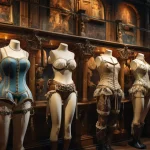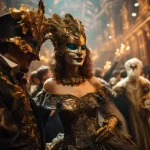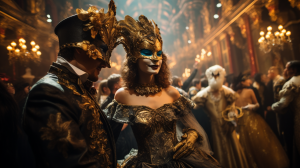
Embarking on a Journey Through Time: The Mystique of Medieval Monastic Fashion
Well, friend, it’s time to hitch up your boots and dust off your curiosity ’cause we’re about to ride the trail of history, deeper and stranger than you might’ve ever imagined. Our quest? Well, it’s a head-scratcher of a story, a yarn woven from the threads of medieval monastic fashion.
🕊️ Step into Yesteryears, Saddle Up for the Unknown 🕊️
Picture yourself back in the day, pilgrim, in the hallowed halls of ancient abbeys, where monks and nuns sauntered about in robes like you’ve never seen. Each piece of fabric, every knot and fold, it all carried a tale of devotion, humility, and a slice of times gone by. We’re gonna mosey on through these sacred spaces, peel back the layers of monastic garb, and shine a light on the deeper meanings within.
🕯️ Illuminating the Secrets of Monastic Dress 🕯️
Our journey ain’t like no other. It’s gonna unfold like an old map, with each section showing a different piece of this here puzzle. From them habits that wrapped the monks in prayer to the veils cloaking the nuns in mystery, we’ll ride the river of time, tracing the changes in monastic gear over the ages.
🌍 Beyond the Abbey: How Monastic Threads Wove into Fashion’s Tapestry 🌍
But, partner, hold onto your hat, ’cause there’s more to this tale than meets the eye. Monastic wear, with its timeless elegance, cast a long shadow on the wider world of style. We’re gonna mosey down that catwalk where monks and nuns whispered their influence to designers, where simplicity became the name of the game, and where echoes of that old monastic grace still resound in modern haute couture.
So, gather ’round, folks, ’cause this here odyssey is gonna be a feast for the senses. Together, we’re gonna uncover the mystique of medieval monastic fashion, where faith and fashion collide in a wild dance through time.
Understanding the Monastic Habit
Welcome to the world of medieval monastic fashion, where attire is more than just clothing; it’s a manifestation of spiritual devotion. In this segment, we’ll embark on a journey through time to explore the significance of the monastic habit, the distinctive clothing worn by monks and nuns in medieval monasteries.
The monastic habit is not just a garment; it’s a symbol of humility and piety. Picture a simple, loose-fitting robe, often made of coarse, unadorned fabric like wool or linen. This robe serves as a reminder of the monks’ renunciation of worldly luxuries, and its design is rooted in centuries of tradition.
Elements of the Habit
Let’s take a closer look at the various elements that make up the monastic habit. Imagine a monk standing before you, clad in this attire.
- The Robe: At the core of the habit is the robe, a long, flowing garment that covers the monk from neck to ankle. It symbolizes modesty and detachment from material possessions. Visualize a brown or black robe, simple in design yet profound in meaning.
- The Hood: Over the robe, there’s a hood that can be pulled up to obscure the face partially. This hood represents humility and anonymity. Imagine a monk with the hood drawn low, focused on prayer and meditation.
- The Belt: Around the waist, a plain belt cinches the robe, creating a sense of structure and discipline. This belt is a reminder of the monk’s commitment to a life of order and self-control.
Now, visualize these elements coming together in a harmonious ensemble. The monastic habit is more than just clothing; it’s a visual representation of a monk’s dedication to a higher purpose.
Symbolism and Spirituality
Each aspect of the monastic habit is infused with deep spiritual symbolism. Picture a monk kneeling in prayer, the habit draped over them like a shroud of devotion.
- The simplicity of the habit reflects the monk’s vow of poverty, emphasizing the rejection of worldly possessions.
- The earthy, subdued colors, often in shades of brown or gray, signify the monk’s connection to the natural world and the humility of their calling.
- The flowing robe, reminiscent of the seamless robe of Christ, symbolizes unity and the indivisibility of faith.
In this way, the habit serves as a constant reminder of the monk’s commitment to a life of prayer, meditation, and service to their community.
Tailoring and Comfort
Now, let’s shift our focus to the practicality of the monastic habit. Imagine a tailor meticulously crafting a habit, paying attention to every detail for the monk’s comfort and functionality.
Despite its simplicity, the habit is tailored to ensure ease of movement during daily activities and long hours of prayer. Imagine monks going about their duties, their habits allowing them to perform tasks with grace and efficiency.
The loose fit of the robe allows for airflow, keeping the wearer cool in summer and providing warmth in the colder months. Visualize the adaptability of the habit, designed to serve the wearer’s needs without distraction.
We’ve peeled back the layers of the monastic habit, revealing its profound significance, simple elegance, and practicality. As we continue our journey through medieval monastic fashion, we’ll delve deeper into the colors, spirituality, and cultural context of these unique garments.
The Role of Color in Monastic Attire
Subtle Hues of Spiritual Significance
In our exploration of medieval monastic fashion, we’ve already uncovered the essentials of the monastic habit and its symbolism. Now, let’s step into a realm where color takes on profound meaning within the monastic community.
Subtle Hues with Profound Significance
Imagine monks and nuns walking the hallowed halls of a medieval monastery, each dressed in their distinct habit. The earthy, subdued colors of their attire convey a sense of simplicity and spirituality.
Brown and Gray: Visualize monks in brown robes and nuns in gray. These understated colors represent a deep connection to the earth and the rejection of worldly luxuries. The brown and gray hues symbolize humility and detachment from material possessions.
White: Occasionally, you might encounter white habits, often worn during significant religious ceremonies. This color signifies purity of heart and soul, reflecting the monks’ commitment to a life of spiritual purity.
Black: In some monastic orders, black robes are prevalent, especially among Benedictines. Black embodies a sense of mourning for one’s sins and the world’s fallen state. Visualize a procession of monks in somber black robes, their attire mirroring their introspective and contemplative lifestyle.
Color as a Marker of Identity
The use of color in monastic attire goes beyond symbolism; it also serves as a marker of identity within the community. Picture a monastery where various orders coexist, each with its unique color-coded habit.
- Benedictines: Envision monks in black robes, embodying a life of discipline and contemplation. Black is their signature color, reflecting the order’s commitment to seeking God through prayer and work.
- Cistercians: See a group of monks clad in white. The Cistercian order emphasizes simplicity and purity in their way of life, and their white habits reflect this devotion.
- Franciscans: Imagine a friar in a brown robe, symbolizing their embrace of poverty and humility in emulation of St. Francis of Assisi.
As you explore this section, picture the serene and orderly world of medieval monastic communities, where color is more than aesthetics—it’s a language of spirituality and identity.
Cultural Context and Continuity
Now, let’s delve into the cultural context of monastic attire. Visualize the medieval landscape, with monasteries dotting the countryside like sanctuaries of devotion and learning.
In the Middle Ages, Europe was a patchwork of kingdoms and regions, each with its cultural nuances. Monastic orders transcended these boundaries, providing continuity in fashion and spirituality. Imagine monks and nuns sharing a common dress code that symbolized their devotion, regardless of their homeland.
The use of color in monastic attire, while deeply rooted in spirituality, also showcased the unity of purpose among various orders. Picture a mosaic of monks and nuns from different backgrounds, all bound by their commitment to a life of prayer and service.
As we continue our journey into medieval monastic fashion, we’ll explore how tailoring and simplicity played crucial roles in shaping these distinctive garments.
Tailoring and Simplicity: Crafting Monastic Garments with Precision
The Art of Creating Humble Attire
In our exploration of medieval monastic fashion, we’ve already delved into the symbolism of the monastic habit and the significance of color. Now, let’s journey into the world of tailoring and simplicity, where the craftsmanship of these humble garments takes center stage.
Subtle Elegance in Practicality
Picture a medieval tailor’s workshop within the confines of a tranquil monastery. Here, skilled artisans work diligently to create the simple yet elegant attire that defines the monastic habit. It’s a process that involves precision, attention to detail, and a deep understanding of the monks’ and nuns’ needs.
The Loose Fit: Visualize the distinctive silhouette of the monastic robe—a loose, flowing garment. This design serves a practical purpose, allowing wearers the freedom of movement required for daily tasks and long hours of prayer and meditation. Imagine monks navigating their monastery with grace, their robes swaying as they go about their duties.
Functional Simplicity: Consider the simplicity of the habit’s design. There are no unnecessary adornments or frills. Instead, it focuses on functionality and comfort. Envision a robe made of coarse, unadorned fabric, durable enough to withstand the rigors of monastic life. The lack of extraneous details symbolizes the monks’ detachment from worldly distractions.
Craftsmanship and Devotion
As we explore the craftsmanship behind monastic attire, imagine a monk or nun standing before you, clad in their habit. The robe may appear simple, but it is a testament to the dedication and devotion of those who crafted it.
Handcrafted with Care: Visualize skilled artisans meticulously cutting and stitching each piece of fabric by hand. They pay close attention to every detail, ensuring the habit fits comfortably and drapes elegantly. The robe is a product of devotion and reverence, mirroring the monks’ commitment to their spiritual path.
The Role of Monastic Seamstresses: In many monasteries, it was often the nuns who undertook the task of crafting the habits. These monastic seamstresses, through their labor, contributed to the spiritual life of the community. Imagine a group of nuns gathered in their sewing room, each stitch infused with prayer and purpose.
Adaptability and Practicality
The adaptability of the monastic habit is another aspect to consider. Visualize monks and nuns going about their daily routines, their attire seamlessly accommodating their activities.
Climate Considerations: In hot summer months, the loose-fitting robe provides airflow, keeping the wearer cool and comfortable. In contrast, during colder seasons, the habit offers warmth and protection. Imagine the monks adapting to the changing seasons, their attire ensuring they can focus on their spiritual duties without distraction.
As we conclude our exploration of tailoring and simplicity in monastic attire, we’ve gained insight into the practical craftsmanship behind these garments. In our next segment, we’ll continue to unravel the layers of medieval monastic fashion by exploring the distinctive attire worn by nuns and the unique symbolism it carries.
Nuns’ Attire: A Cloak of Devotion and Modesty
The Feminine Grace of Monastic Fashion
As we continue our journey through the annals of medieval monastic fashion, we now turn our attention to the unique attire worn by nuns. In this section, we’ll explore the distinctive elements of nuns’ habits and the profound symbolism embedded within each garment.
The Veil: A Symbol of Spiritual Covering
Imagine a serene convent, where nuns in their distinctive attire gather for prayer and contemplation. At the heart of a nun’s habit is the veil, a symbol of modesty, humility, and devotion.
The Wimple: Visualize a wimple, a piece of white fabric that covers a nun’s head and neck, leaving only her face exposed. This modest garment represents a nun’s separation from the distractions of the world and her commitment to a life of prayer. The wimple is a reflection of inner beauty and piety.
The Coif: Beneath the wimple, there’s a coif, a close-fitting cap that secures the veil in place. It ensures that the veil remains modest and unobtrusive. Envision nuns carefully arranging their coifs, a ritual that signifies their readiness for prayer and reflection.
The Tunic and Scapular: A Life of Simplicity
A nun’s habit is characterized by its simplicity and modesty. Visualize a nun in her tunic, a long, flowing garment that drapes gracefully from neck to ankle.
The Scapular: Over the tunic, a nun wears a scapular—a rectangular piece of fabric that covers the front and back of her body. It is a symbol of servitude and work. Picture nuns engaged in various tasks within the convent, their scapulars a constant reminder of their commitment to a life of service and humility.
The Belt: Similar to monks, nuns also wear a plain belt around their waist. This belt serves as a reminder of their vow of chastity and self-control. Envision nuns tightening their belts as they prepare for prayer, symbolizing their dedication to a life of purity.
The Influence of Nuns’ Attire on Modern Fashion
While the attire of medieval nuns may appear humble, its influence can still be seen in modern fashion. Visualize contemporary fashion designers drawing inspiration from the simplicity and elegance of nuns’ habits. The clean lines, modesty, and dedication to craftsmanship continue to resonate with designers and fashion enthusiasts alike.
As we conclude our exploration of nuns’ attire, we’ve uncovered the layers of symbolism and grace that define their garments. In our next segment, we’ll take a step back in time to explore the evolution of monastic fashion across different historical periods.
The Evolution of Monastic Fashion: A Journey Through Time
Witnessing the Ebb and Flow of Monastic Attire
Our voyage through the fascinating world of medieval monastic fashion takes us deeper into history. In this section, we’ll embark on a time-traveling adventure, exploring how monastic attire evolved across different historical periods.
Early Christian Simplicity
Visualize the early days of Christianity, where the roots of monasticism began to take hold. Monks and nuns in the early Christian era donned simple, unadorned garments that reflected the humility of their faith. Picture these pioneers of monasticism, their attire echoing the teachings of Christ, who valued spiritual riches over material wealth.
Placeholder Image: Consider placing an image from early Christian monastic life here, depicting monks and nuns in their modest attire, living a life of devotion and contemplation.
The Flourishing Middle Ages
As we progress through history, envision the flourishing of monastic communities during the Middle Ages. Monasteries became centers of learning and culture. With the passage of time, monastic attire evolved while still maintaining its core principles of simplicity and humility.
Placeholder Image: Consider including an image that captures the vibrancy of medieval monastic life, showcasing monks and nuns in elaborately designed habits reflecting the fashion of the era.
The Renaissance Influence
Imagine the Renaissance era, where the world was experiencing a rebirth of art, culture, and knowledge. Even within the walls of monasteries, the Renaissance had an impact on fashion. Visualize monks and nuns in finely tailored habits adorned with intricate embroidery and details. The Renaissance brought a touch of luxury to monastic attire, reflecting the cultural trends of the time.
Placeholder Image: Include an image representing the Renaissance influence on monastic fashion, highlighting the intricate details and craftsmanship of the habits.
The Counter-Reformation and Simplicity Returns
As we move forward in time, picture the Counter-Reformation, a period of spiritual renewal within the Catholic Church. During this time, there was a return to the simplicity and modesty of early monastic fashion. Visualize monks and nuns once again wearing plain, unadorned habits, recommitting themselves to a life of piety and devotion.
Placeholder Image: Consider an image that contrasts the opulence of the Renaissance with the renewed simplicity of monastic attire during the Counter-Reformation.
The Modern Continuation
Now, envision the continuation of monastic attire into the modern era. While the world has undergone significant changes, monastic communities still embrace their distinctive clothing. Picture contemporary monks and nuns in habits that honor tradition while adapting to the needs of the present.
Placeholder Image: Include an image that showcases modern-day monastic fashion, illustrating the continuity of tradition and devotion in the 21st century.
As we conclude our exploration of the evolution of monastic fashion, we’ve witnessed the ebb and flow of style, from early Christian simplicity to the influence of the Renaissance and the return to modesty during the Counter-Reformation. In our next section, we’ll shift our focus to the influence of monastic fashion on secular clothing trends.
Monastic Fashion’s Influence on Secular Trends: A Ripple in the Sartorial Stream
From Cloistered Garb to the Runway
Our exploration of medieval monastic fashion has unveiled a rich tapestry of attire rooted in spirituality and simplicity. In this section, we’ll journey beyond the walls of monasteries to discover how monastic fashion has rippled through the broader world of secular clothing trends.
A Whisper of the Monastic Aesthetic
Picture the fashion landscape of the late Middle Ages, where the influence of monastic attire began to subtly seep into secular clothing. While nobles and courtiers reveled in opulent attire, there was a growing fascination with the monastic aesthetic among the fashion-forward.
Placeholder Image: Consider an image from this era, showcasing the fusion of monastic elements into secular fashion, such as simple, loose-fitting robes and hoods incorporated into courtly attire.
The Simplicity Movement
As we progress through history, visualize the emergence of simplicity movements in fashion. Inspired by the monastic ideals of modesty and humility, there were periods when society embraced unadorned, functional clothing. Imagine the contrast between elaborate court gowns and the trend towards simpler, more practical attire.
Placeholder Image: Include an image representing the simplicity movement, with individuals dressed in unembellished garments influenced by monastic fashion.
Contemporary Echoes
Now, fast forward to the modern era. Visualize the echoes of monastic fashion in contemporary clothing trends. The minimalist movement, characterized by clean lines, understated elegance, and a focus on functionality, can be seen as a continuation of the monastic aesthetic.
Placeholder Image: Consider an image that captures the essence of modern minimalism in fashion, highlighting the influence of monastic simplicity.
High Fashion Homage
Imagine the world of high fashion, where renowned designers pay homage to the monastic aesthetic. Runway collections occasionally feature garments that echo the simplicity and elegance of monastic attire. Visualize a fashion show where models strut down the catwalk in robes reminiscent of monastic habits, showcasing the enduring allure of this timeless style.
Placeholder Image: Include an image from a high-fashion runway show that incorporates elements of monastic fashion, demonstrating its enduring influence on couture.
A Timeless Influence
As we conclude our exploration of monastic fashion’s influence on secular trends, we’ve traced a sartorial journey that spans centuries. From the whispered echoes of the Middle Ages to the contemporary runway, the monastic aesthetic continues to leave its mark on the world of fashion.
Conclusion and Reflections: Unveiling the Timeless Elegance of Monastic Fashion
Where Spirituality Meets Style
Our voyage through the annals of medieval monastic fashion has been a journey of discovery and appreciation for the intricate tapestry of attire that weaves together spirituality, history, and style. In this final section, we’ll reflect on the profound impact of monastic fashion and the enduring allure it holds.
A Tapestry of Symbolism
As we look back at our exploration, we’re reminded of the depth of symbolism woven into each element of monastic attire. From the simplicity of the habit to the significance of color and the grace of nuns’ veils, monastic fashion is a language of devotion and modesty. Visualize the monks and nuns who, through their attire, communicated their commitment to a life of prayer and service.
Placeholder Image: Consider an image that captures the richness of symbolism in monastic attire, with various elements of habits depicted together as a harmonious whole.
Evolution and Adaptation
Our journey also unveiled the evolution of monastic fashion across different historical periods. From early Christian simplicity to the opulence of the Renaissance and the return to modesty during the Counter-Reformation, monastic attire adapted to the changing tides of history. Visualize the monks and nuns of each era, their attire reflecting the cultural trends and spiritual values of their time.
Placeholder Image: Include an image that showcases the evolution of monastic fashion, with garments from different historical periods side by side.
Influence Beyond the Cloister
Monastic fashion’s influence extends far beyond the cloistered walls of monasteries. It whispers through the corridors of secular fashion, leaving its mark on minimalist movements, simplicity trends, and even high fashion runways. Imagine the designers who draw inspiration from the timeless elegance of monastic attire, creating garments that echo its grace and modesty.
Placeholder Image: Consider an image from a high-fashion runway show that pays homage to monastic fashion, illustrating its enduring influence in the world of couture.
A Timeless Elegance
In our exploration, we’ve come to appreciate the enduring elegance of monastic fashion. It serves as a reminder that simplicity and spirituality can be seamlessly woven into the fabric of style. As we conclude our journey, let’s reflect on the monks and nuns who, through their attire, shared their devotion and humility with the world.








